中国传统文化简介(中英文并存)
中国传统文化简介-英文

Clothing
The historical trade route between China and the West was called the “the Silk Road.”
The Silk Road was not a trade route that existed solely for the purpose of trading in silk; many other commodities were also traded, from gold and ivory to exotic animals and plants. Of all the precious goods crossing this area, silk was perhaps the most remarkable for the people of the West.
Clothing
Silk is a Chinese invention. Silk is one of the oldest known textile fibers and, according to Chinese tradition, was used as long ago as the 27th century BC. The silkworm moth was originally a native of China, and for about 30 centuries the gathering and weaving of silk was a secret process, known only to the Chinese.
The invention of paper is a great contribution to the world made by Chinese people!
中国文化介绍英文版Chinese Culture introduction

The commonly used techniques and styles in Chinese painting include ink painting, meticulous painting, freehand brushwork, etc., each with its unique aesthetic value and artistic expression.
Chinese Ceramics and Chinese Knives
Chinese porcelain is most famous for porcelain from Jingdezhen, Longquan Kiln, and other places, with a history dating back to the Tang Dynasty.
03
Buddhism and Zen Buddhism have a deep impact on Chinese culture, including Chinese poetry, calligraphy, painting, music, and folk customs They also spread to other countries and regions in the world
The Origin of Chinese Culture
The origin of Chinese culture can be traced back to the Yellow River basin, which is considered the slogan of Chinese civilization The Yellow River is an important river in China that has nurtured the growth of many urban civilizations
中国传统文化(中英文)

中国传统文化一、“传统节日”单词预热vocabulary work烹调cooking cuisine鱼肉满架well stocked with fish and meat象征意义symbolic significance农历lunar calendar阳历solar calendar端午节Dragon Boat Festival元宵节Lantern Festival清明节Pure Brightness Day重阳节Double Ninth Day放逐be exiled忠臣loyal minister糯米粽子glutinous rice dumplings wrapped in bamboo leaves 祭祀亡灵in memory of sb.龙舟比赛dragon boat races中秋节Mid Autumn Festival满月full moon月饼moon cake蜜饯preserved fruits豆沙bean paste蛋黄egg yolk海鲜seafood家禽poultry饺子dumplings八宝饭eight treasure rice米羹rice balls油条fried sticks麻花fried twisted stick炒面Chaomian叉烧包steamed bun with roast pork粥porridge芋头taro葱油饼pan-fried cake with sesame seeds and green onion有关春节的常用词放鞭炮let off firecrackers耍龙灯play the dragon lantern耍狮子play the lion dance拜年pay a new-year callChinese to English:1. 玉器是光辉灿烂的中华民族历史文化宝库中一枝异彩独放的奇葩。
中国玉器在新石器时代的河姆渡文化时期就开始出现。
7000年来一直延续不断,发展至今。
中国传统文化介绍(英文版)

栏目索引与介绍•当前位置: 主页/•中外文化/中国文化随着中国加入世界贸易组织,中国将进一步对外开放,中国经济与世界经济更加融合。
因此,将中华民族悠久的历史和灿烂的文化介绍给世界各国人民是所有英语爱好者应尽的责任。
开辟这个栏目,就是为了适应对外宣传的需要。
我们将在此介绍中国历史、音乐、绘画、考古、旅游、经济、宗教等方面的情况。
那些从事中国文化教学与研究的师生会在这里找到一些参考资料和英语表达方式。
中国文化知识漫谈(中文)中国文化美国行(新闻报道与背景介绍)Culture Relics文化古迹Travel Features旅游Wushu/Qigong武术与气功Opera/Theatre戏曲Galleries/Museums美术馆与博物馆Peking Opera中国京剧Events/Festivals节日与民俗Local Opera中国地方戏Chinese New Year's Day中国新年来历与24节气Dance Drama and Ballet中国舞剧与芭蕾Traditions of Chinese New Year中国新年除夕习俗Modern Chinese Drama中国话剧Do's and Don'ts of Chinese New Year 中国新年禁忌Acrobatics, Puppet and Shadow Shows杂技、木偶戏与皮影The History of Lion Dance中国舞狮Quyi Performances中国曲艺表演The History of Fireworks中国鞭炮Paintings/Handicrafts绘画与工艺品Lantern Festival元宵节成语典故一 (三国演义、西游记)Brithday of Confucius孔子生日成语典故二Birthday of Mazoo妈祖生日成语典故三Dragon Boat Festival端午节成语典故四Moon Festival中秋节中国古代简史中国文学(包括古文、近代、现代与当代文学以及文化传统,作家传记)中国诗歌英译 (请综合训练中翻译技巧栏目)中国旅游《旅游英语》网络课程中国旅游十大特色中国西藏北京景点天坛中国美食故宫中国十二生肖:12 Taditional Zodiacs M usic音乐RAM HORSE Solo Recordings中国音乐独奏MONKEY ROOSTER CollectedRecordings中国音乐集锦SNAKE DRAGON TraditionalChinese中国传统乐器与音乐InstrumentalmusicDOG PIG Classical Music中国古典音乐OX TIGERRABBIT RAT中国文化知识漫谈(一)文化的含义什么叫文化?《易经》上说:“观乎天文,以察时变,观乎人文,以化成天下。
介绍中国传统文化英文
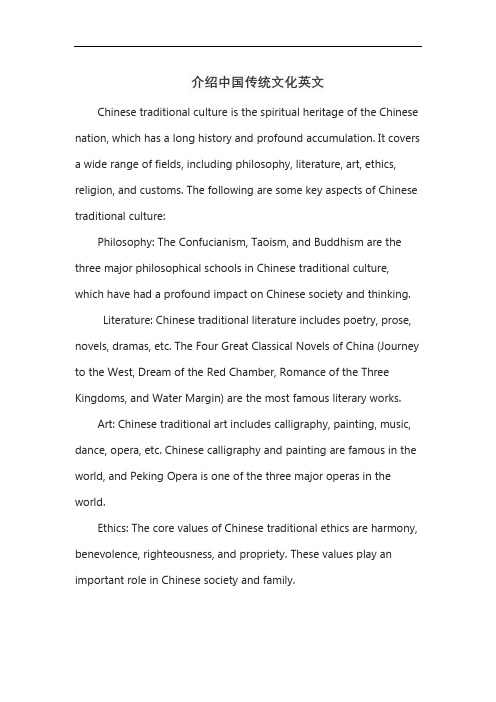
介绍中国传统文化英文Chinese traditional culture is the spiritual heritage of the Chinese nation, which has a long history and profound accumulation. It covers a wide range of fields, including philosophy, literature, art, ethics, religion, and customs. The following are some key aspects of Chinese traditional culture:Philosophy: The Confucianism, Taoism, and Buddhism are the three major philosophical schools in Chinese traditional culture, which have had a profound impact on Chinese society and thinking.Literature: Chinese traditional literature includes poetry, prose, novels, dramas, etc. The Four Great Classical Novels of China (Journey to the West, Dream of the Red Chamber, Romance of the Three Kingdoms, and Water Margin) are the most famous literary works.Art: Chinese traditional art includes calligraphy, painting, music, dance, opera, etc. Chinese calligraphy and painting are famous in the world, and Peking Opera is one of the three major operas in the world.Ethics: The core values of Chinese traditional ethics are harmony, benevolence, righteousness, and propriety. These values play an important role in Chinese society and family.Religion: Chinese traditional religion includes Buddhism, Taoism, and Islam. These religions have had a profound impact on Chinese society and culture.Custom: Chinese traditional customs include Spring Festival, Mid-Autumn Festival, Dragon Boat Festival, etc. These customs reflect the cultural traditions and values of the Chinese nation.In short, Chinese traditional culture is a rich and diverse cultural system that has had a profound impact on Chinese society and the world. It is the spiritual pillar of the Chinese nation and an important part of world culture.。
中国文化英文介绍

Confucius named Qiu styled Zhongni, a great thinker and educator in the late Spring and Autumn Period, and the founder of Confucianism. Confucius instructed more than 3000 disciples and some were from poor families. Confucius gradually changed the tradition that only nobilities had the right to receive education. In his later years , Confucius compiled many literary works of ancient times, including The Book of Songs ,The Book of Documents, and The Books of Changes. His saying and behaviors were compiled in The Analects of Confucius by his disciples. His ideology has been absorbed and carried composing the essential part of Chinese traditional ideology. It was also spread into the border regions and areas building up a circle of Confucianism. UNESCO labeled him one of the “Ten Culture Celebrities”.孔子孔子名丘字仲尼,春秋末期伟大的思想家和教育家,儒家学派创史人。
中国传统文化(中英文)
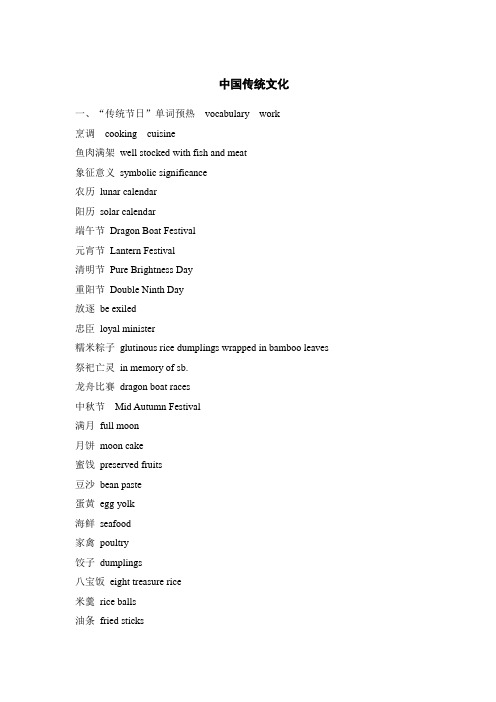
中国传统文化一、“传统节日”单词预热vocabulary work烹调cooking cuisine鱼肉满架well stocked with fish and meat象征意义symbolic significance农历lunar calendar阳历solar calendar端午节Dragon Boat Festival元宵节Lantern Festival清明节Pure Brightness Day重阳节Double Ninth Day放逐be exiled忠臣loyal minister糯米粽子glutinous rice dumplings wrapped in bamboo leaves 祭祀亡灵in memory of sb.龙舟比赛dragon boat races中秋节Mid Autumn Festival满月full moon月饼moon cake蜜饯preserved fruits豆沙bean paste蛋黄egg yolk海鲜seafood家禽poultry饺子dumplings八宝饭eight treasure rice米羹rice balls油条fried sticks麻花fried twisted stick炒面Chaomian叉烧包steamed bun with roast pork粥porridge芋头taro葱油饼pan-fried cake with sesame seeds and green onion有关春节的常用词放鞭炮let off firecrackers耍龙灯play the dragon lantern耍狮子play the lion dance拜年pay a new-year callChinese to English:1. 玉器是光辉灿烂的中华民族历史文化宝库中一枝异彩独放的奇葩。
中国玉器在新石器时代的河姆渡文化时期就开始出现。
7000年来一直延续不断,发展至今。
介绍中国传统文化英语

介绍中国传统文化英语文章The Rich Tapestry of Chinese Traditional CultureChina, a civilization dating back thousands of years, is renowned for its profound and diverse culture. This rich heritage is deeply ingrained in the country's history, philosophy, art, literature, architecture, and even its cuisine, making it a fascinating tapestry of traditions and customs.Philosophy and ReligionConfucianism, Buddhism, and Taoism are the three main philosophical and religious traditions in China. Confucianism, founded by Confucius in the 6th century BCE, emphasizes personal and governmental morality, righteousness, loyalty, and filial piety. It has had a profound influence on Chinese society, shaping its ethics, social structure, and political philosophy.Buddhism was introduced to China from India in the 1st century CE and quickly assimilated into Chinese culture. It taught the principles of non-attachment, compassion, and the cycle of rebirth. The fusion of Buddhism with native beliefs and practices resulted in distinctively Chinese sects like Chan (Zen) Buddhism.Taoism, or Daoism, originates from the teachings of Lao Tzu and Chuang Tzu. It advocates harmony with nature, simplicity, and wu wei (non-action). Taoist beliefs include the existence of an ultimate principle called the Tao, which guides the universe.Arts and LiteratureChinese literature is extensive and varied. Classical poetry, particularly shi poetry, is highly regarded for its conciseness and depth of emotion. Poets like Du Fu and Li Bai are celebrated for their works. Chinese calligraphy is an art form in itself, with each stroke of the brush revealing the artist's temperament and state of mind.Traditional Chinese painting, known as guó huà, often features landscapes, birds, and flowers. It emphasizes spirit over form and typically uses ink and watercolors. The T erracotta Warriors, discovered in Xi'an, are a stunning example of ancient Chinese sculpture, demonstrating the sophistication of their craftsmanship.Architecture and GardensChinese architecture is characterized by its use of wood, tile, and intricate details. The Forbidden City in Beijing is a prime example of imperial architecture, reflecting harmony with nature and symmetry. Chinese gardens are also a testament to the culture's aesthetic sensibilities. They feature rockeries, ponds, pavilions, and winding paths that aim to create a harmonious microcosm of the natural world.CuisineChinese cuisine is renowned worldwide for its diverse flavors and cooking techniques. It reflects the country's vast geography, ranging from spicy Sichuan dishes to Cantonese dim sum to Beijing's famous Peking duck. Common ingredients like rice, noodles, soy sauce, and various meats and vegetables are transformed into countless delicious dishes through stir-frying, steaming, and braising. T ea culture is also deeply ingrained in Chinese society, with tea ceremonies and the art of tea-making being anintegral part of social gatherings.Festivals and TraditionsChinese festivals are vibrant displays of culture and tradition. The Spring Festival, or Chinese New Year, is the most significant, marked by family reunions, fireworks, red envelopes (hongbao), and the Dragon Dance to ward off evil spirits and bring good luck. The Mid-Autumn Festival, Mooncake Festival, is another major celebration where families gather to admire the full moon and eat mooncakes. Other notable festivals include the Dragon Boat Festival with its dragon boat races and the eating of zongzi (sticky rice dumplings) and the Lantern Festival with its display of colorful lanterns.In conclusion, Chinese traditional culture is a multifaceted and rich heritage that has been passed down through generations. It is a blend of philosophy, art, literature, architecture, cuisine, and festivals that continue to thrive and evolve even in today's modern world. This cultural tapestry not only defines China but also contributes significantly to global culture and civilization.。
(完整word版)中国文化英文介绍
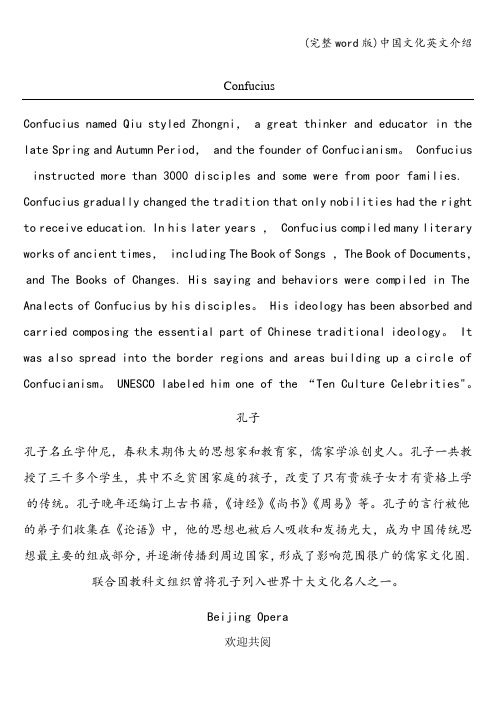
ConfuciusConfucius named Qiu styled Zhongni, a great thinker and educator in the late Spring and Autumn Period, and the founder of Confucianism。
Confucius instructed more than 3000 disciples and some were from poor families. Confucius gradually changed the tradition that only nobilities had the right to receive education. In his later years , Confucius compiled many literary works of ancient times, including The Book of Songs ,The Book of Documents,and The Books of Changes. His saying and behaviors were compiled in The Analects of Confucius by his disciples。
His ideology has been absorbed and carried composing the essential part of Chinese traditional ideology。
It was also spread into the border regions and areas building up a circle of Confucianism。
UNESC O labeled him one of the “Ten Culture Celebrities"。
中国传统文化(中英文)

中国传统文化烹调cooking cuisine象征意义symbolic significance农历lunar calendar阳历solar calendar端午节Dragon Boat Festival元宵节Lantern Festival清明节Pure Brightness Day重阳节Double Ninth Day放逐be exiled忠臣loyal minister糯米粽子glutinous rice dumplings wrapped in bamboo leaves 祭祀亡灵in memory of sb.龙舟比赛dragon boat races中秋节Mid Autumn Festival满月full moon月饼moon cake蜜饯preserved fruits豆沙bean paste蛋黄egg yolk海鲜seafood家禽poultry饺子dumplings八宝饭eight treasure rice米羹rice balls油条fried sticks麻花fried twisted stick炒面Chaomian叉烧包steamed bun with roast pork粥porridge芋头taro葱油饼pan-fried cake with sesame seeds and green onion有关春节的常用词放鞭炮let off firecrackers耍龙灯play the dragon lantern耍狮子play the lion dance拜年pay a new-year call中国古代独特事物(Unique Ancient Chinese Items)宣纸rice paper衙门yamen叩头kowtow孔子Confucius武术 wushu(Chinese Martial Arts)功夫kungfu ;kung fu中庸the way of medium (cf. Golden Means)中和harmony (zhonghe)孝顺to show filial obedience孝子dutiful son家长family head三纲:君为臣纲,父为子纲,夫为妻纲three cardinal guides: ruler guides subject, father guides son husband guides wife五常:仁、义、理、智、信five constant virtues: benevolence (humanity), righteousness, propriety, wisdom and fidelity八股文eight-legged essays多子多福:The more sons/children, the more blessing/ great happiness养儿防老:raising sons to support one in one’s old age1.元宵节:Lantern Festival2.刺绣:embroidery3.重阳节:Double-Ninth Festival4.清明节:Tomb sweeping day5.剪纸:Paper Cutting6.书法:Calligraphy7.对联:(Spring Festival) Couplets8.象形文字:Pictograms/Pictographic Characters9.人才流动:Brain Drain/Brain Flow10.四合院:Siheyuan/Quadrangle11.战国:Warring States12.风水:Fengshui/Geomantic Omen13.铁饭碗:Iron Bowl14.函授部:The Correspondence Department15.集体舞:Group Dance16.黄土高原:Loess Plateau17.红白喜事:Weddings and Funerals18.中秋节:Mid-Autumn Day19.结婚证:Marriage Certificate20.儒家文化:Confucian Culture21.附属学校:Affiliated school22.古装片:Costume Drama23.武打片:Chinese Swordplay Movie24.元宵:Tangyuan/Sweet Rice Dumpling (Soup)25.一国两制:One Country, Two Systems26.火锅:Hot Pot27.四人帮:Gang of Four28.《诗经》:The Book of Songs29.素质教育:Essential-qualities-oriented Education30.《史记》:Historical Records/Records of the Grand Historian31.大跃进:Great Leap Forward (Movement)32.《西游记》:The Journey to the West33.除夕:Chinese New Year’s Eve/Eve of the Spring Festival34.针灸:Acupuncture35.唐三彩:Tri-color Pottery of the Tang Dynasty/ The Tang Tri-colored pottery36.中国特色的社会主义:Chinese-charactered Socialist/Socialist with Chinese characteristics37.偏旁:radical38.孟子:Mencius39.亭/阁:Pavilion/ Attic40.大中型国有企业:Large and Medium-sized State-owned Enterprises41.火药:gunpowder42.农历:Lunar Calendar43. 印/玺:Seal/Stamp44. 物质精神文明建设:The Construction of Material Civilization and Spiritual Civilization45.京剧:Beijing Opera/Peking Opera46.秦腔:Crying of Qin People/Qin Opera47.太极拳:Tai Chi实考题分析中国的传统节庆膳食除了在数量和质量上与平时有所不同之外,一些历史悠久、具有象征意义的食物也是节日必不可缺的伴侣。
中国传统文化介绍(英文版)
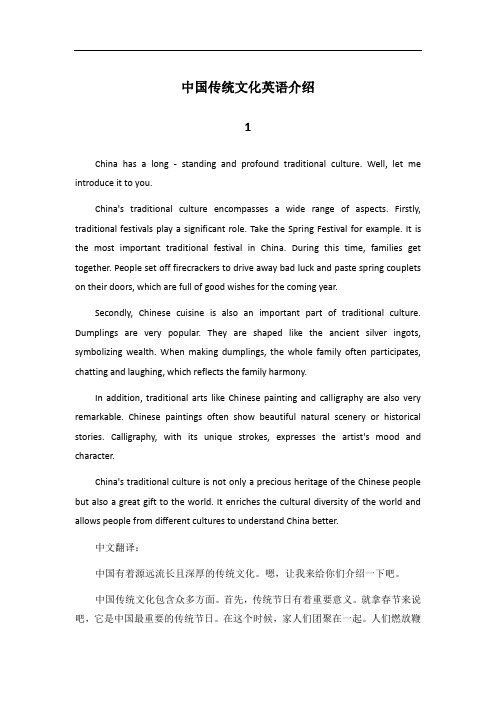
中国传统文化英语介绍1China has a long -standing and profound traditional culture. Well, let me introduce it to you.China's traditional culture encompasses a wide range of aspects. Firstly, traditional festivals play a significant role. Take the Spring Festival for example. It is the most important traditional festival in China. During this time, families get together. People set off firecrackers to drive away bad luck and paste spring couplets on their doors, which are full of good wishes for the coming year.Secondly, Chinese cuisine is also an important part of traditional culture. Dumplings are very popular. They are shaped like the ancient silver ingots, symbolizing wealth. When making dumplings, the whole family often participates, chatting and laughing, which reflects the family harmony.In addition, traditional arts like Chinese painting and calligraphy are also very remarkable. Chinese paintings often show beautiful natural scenery or historical stories. Calligraphy, with its unique strokes, expresses the artist's mood and character.China's traditional culture is not only a precious heritage of the Chinese people but also a great gift to the world. It enriches the cultural diversity of the world and allows people from different cultures to understand China better.中文翻译:中国有着源远流长且深厚的传统文化。
中国传统文化(中英文)

中国传统文化一、“传统节日”单词预热vocabulary work烹调cooking cuisine鱼肉满架well stocked with fish and meat象征意义symbolic significance农历lunar calendar阳历solar calendar端午节Dragon Boat Festival元宵节Lantern Festival清明节Pure Brightness Day重阳节Double Ninth Day放逐be exiled忠臣loyal minister糯米粽子glutinous rice dumplings wrapped in bamboo leaves 祭祀亡灵in memory of sb.龙舟比赛dragon boat races中秋节Mid Autumn Festival满月full moon月饼moon cake蜜饯preserved fruits豆沙bean paste蛋黄egg yolk海鲜seafood家禽poultry饺子dumplings八宝饭eight treasure rice米羹rice balls油条fried sticks麻花fried twisted stick炒面Chaomian叉烧包steamed bun with roast pork粥porridge芋头taro葱油饼pan-fried cake with sesame seeds and green onion有关春节的常用词放鞭炮let off firecrackers耍龙灯play the dragon lantern耍狮子play the lion dance拜年pay a new-year call二、有关“介绍”的翻译•我很高兴向各位介绍中国的主要传统节日。
→I am very happy to have the opportunity to talk to you about major traditional Chinese holidays.表示“介绍情况”时,我们可以这样翻译:1.to share with you brief information•在此,我愿意向朋友们介绍这些方面的情况。
中国传统文化简介(中英双语)34页PPT文档

功夫之王—李小龙
Hong Kong kungfu star Bruce Lee's family plans to shoot a new movie about the martial arts and film legend to dispel the myths that have arisen since his death 33 years ago. Speaking at a gathering to mark the anniversary of the star's death in 1973, younger brother Robert Lee Chun-fai said the legend had never faded but few people knew the real Bruce Lee. He said this year the whole family decided to launch a book to mark his birthday in November and they would record a film to show the other side of Bruce, how he was growing up, his secrets and his philosophy from the never-seen perspective of his brothers and sisters. The film will be shot next year by JA Media in co-operation with brothers Robert and Peter and sisters Phoebe and Agnes, and is scheduled to air on the 35th anniversary of Bruce Lee's death in 2019. JA Media movie producer Stephen Shin Kei-yin said they would trawl the world to find the right actor to portray Lee
中国传统文化英文版
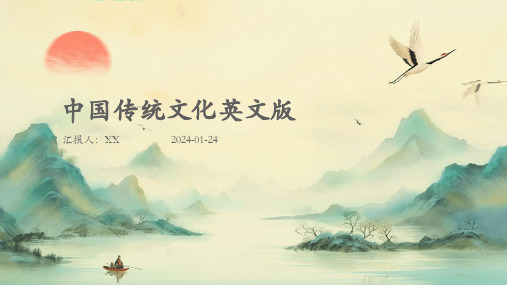
Promoting the development of tourism industry: China's traditional culture is one of the important factors that attract international tourists. Through the English version of the introduction, it can attract more tourists to visit China and promote the development of the tourism industry.
• Liu Du Wan Xing: Summarizes the main contents and methods of Bodhisattva practice, including giving, holding precepts, enduring humiliation, improving oneself, meditating, and wisdom.
03
Bian Ge Si Xiang advocates adapting to social changes and carrying out political, economic,
and other reforms.
04
Utilitarianism (Gong Li Zhu Yi): Pursuing practical benefits and effects, emphasizing utilitarianism and practicality.
Emphasizing the importance of knowledge and wisdom, encouraging people to pursue truth and wisdom.
中国传统文化(中英对照)

中国传统⽂化(中英对照)莫逆之交:bosom friends总⾓之交:friendship between people who are friends since childhood⼀般作宾语,指⼉时的朋友。
总⾓:古代未成年的⼈把头发扎成髻。
借指童年时期,幼年。
总⾓是⼋九岁⾄⼗三四岁的少年,古代⼉童将头发分作左右两半,在头顶各扎成⼀个结,形如两个⽺⾓,故称“总⾓”。
贫贱之交:friendship between people who are poverty-stricken and from humble circumstances杵⾅之交:friendship between people who do not care about the financial condition and social status of each other 杵:舂⽶的⽊棒;⾅:⽯⾅。
⽐喻交朋友不计较贫富和⾝分。
君⼦之交:friendship between gentlemen⼩⼈之交:friendship between villains狐朋狗友:people who often gather together doing something meaningless and even illegal棋友/牌友/球友:people who often meet to play chess, poker, ball. etc.战友:people who get to know each other while serving in the same army unit普通⽼百姓交的朋友谓“布⾐之交”;有钱⼈与没钱⼈交朋友谓“车笠之交”;在逆境中结交的朋友称“患难之交”;吃喝玩乐结交的朋友称“酒⾁之交”;年岁差别⼤,⾏辈不同⽽交情深厚的朋友称“忘年之交”;幼年相交的朋友称“⽵马之交”;交情深厚的朋友谓“肺腑之交”;亲密⽆间的朋友谓“胶漆之交”;⽣死与共的朋友谓“⽣死之交”;情投意合的朋友称“莫逆之交”;哪怕砍头也不改变友谊的朋友称“刎颈之交”;⽆意中相遇⽽结成的朋友称“邂逅之交”;在道义上互相⽀持的朋友称“君⼦之交”;只见过⼀次⾯,交情不深的朋友称“⼀⾯之交”;仅点头打招呼,感情不深的朋友称“点头之交”;平淡⽽浮泛交往的朋友称“泛泛之交”;见过⾯但不熟悉的⼈称“半⾯之交”;旧时结拜的兄弟姊妹称“⼋拜之交”;交友不嫌贫贱称“杵逆之交”;宝贵⽽有价值的交往称“⾦⽟之交”。
中国文化介绍--中英文对照

十二属相中国民间有一个传统习俗,人一出生,就有一种动物做他的属相。
属相,也叫“生肖”,是中国民间传统的纪年和计算年龄的方法。
中国古代的纪年法是帝王年号与“干支”并用,其中“干支纪年法”从史书上有明文记载的公元前841年(庚申年),一直沿用到现在。
“干”是“天干”,有十个字组成,这十个字是:甲、乙、丙、丁、戊、己、庚、辛、壬、癸。
“支”是“地支”,由十二个字组成,这十二个字是:子、丑、寅、卯、辰、巳、午、未、申、酉、戌、亥。
把天干的十个字和地支的十二个字按顺序配合起来,可以得到60种排列,如:甲子、乙丑、丙寅……这60种排列周而复始,循环使用,每六十年叫做“一个甲子”。
如公历的2001年,是农历的辛巳年,公历的2002年,是农历的壬午年;而六十年后,2061年又是辛巳年,2062年又是壬午年。
从东汉(25——220)时开始,人们又用鼠、牛、虎、兔、龙、蛇、马、羊、猴、鸡、狗、猪12种动物来配十二地支,组成了十二生肖,也叫十二属相。
这就是子鼠、丑牛、寅虎、卯兔、辰龙、巳蛇、午马、未羊、申猴、酉鸡、戌狗、亥猪。
这样,子年是鼠年,丑年是牛年,寅年是虎年……于是,每个人一出生,就有一种动物作他的属相。
子年出生的属鼠,丑年出生的属牛,寅年出生的属虎,以此类推。
现在,中国人在用公历纪年和计算年龄的同时,仍然习惯用属相纪年和推算年龄。
twelve symbolic animalsit is traditional in China,when a perpon is born,one animal(shuxiang)is used to symbolize this year.Shuxiang,also called shengxiao(any ofthe12animals representing the Earthly Branches),is a traditional way in China to number the years and to record a person's age.The ancient Chinese people invented the method to designate the years by the Heavenly Stems consist of the characters:jia,yi,bing,ding,wu,ji,geng,xin,ren,and gui.And the Earthly Branches are composed of12characters:zi,shu,yin,mao,chen,si,wu,wei,shen,you,xu,bining each of the 10Heavenly Stems with one of the12Earthly Branches in sequence creates60 chronological symbols.For example jiazi,yichou,bingyin,etc.These60symbols are used in circles and thus each year has a chronological symbol.For example,2001 corresponds to xinsi,2002to renwu in the lunar calendar;after60years,2061,once again,corresponds to xinsi,and2062,to ter,people used12animalsto correspond to the12Earthly Branches,forming the12Symbolic Animals,namely Earthly Branch One Rat,Earthly Branch Two Ox,Earthly Branch ThreeTiger,Earthly Branch Four Rabbit,Earthly Branch Five Dragon,Earthly Branch Six Snake,Earthly Branch Seven Horse,Earthly Branch Eight Sheep,Earthly Branch Nine Monkey,Earthly Branch Ten Rooster,Earthly Branch Eleven Dog,Earthly Branch Twelve Pig.Thus the zi year is the Year of the Rat,and the chou Year is the year of the Ox,and the yin Year is the Year of the Year ofTiger,etc.Therefore,when a person is born,he has an animal as his aymbolic animal.The year2002was a renwu year under lunar calendar,also the year of Horse,and so children born in this yea are all Horse babies.Even though the Chinese people now number the years and their age under the Gregorian calendar,the still continue to use the symbolic animals.As long as people know a person'probable age and his symbolic animao,people can infer his exact age and year of birth.小孩儿满月与抓周在中国,小孩儿的满月酒和抓周仪式独具特色。
用英语介绍中国传统文化 pdf

用英语介绍中国传统文化pdf全文共3篇示例,供读者参考篇1Introduction to Traditional Chinese CultureChinese culture is one of the oldest and richest in the world, with a history that dates back thousands of years. It encompasses a wide range of traditions, customs, and practices that have been passed down through generations. In this document, we will explore some of the key aspects of traditional Chinese culture, including art, literature, philosophy, and food.ArtChinese art is diverse and multifaceted, encompassing a wide range of styles and mediums. Traditional Chinese painting, calligraphy, and pottery are highly esteemed for their beauty and elegance. Chinese artists often draw inspiration from nature, with landscapes, flowers, and animals being popular subjects. Traditional Chinese paintings are characterized by their use of brush strokes, ink washes, and vibrant colors.LiteratureChinese literature is one of the oldest and most influential in the world. The Chinese language is rich and expressive, allowing for a wide range of literary forms, including poetry, prose, and drama. Classic works such as "The Art of War" by Sun Tzu, "Journey to the West" by Wu Cheng'en, and "Dream of the Red Chamber" by Cao Xueqin are widely regarded as masterpieces of Chinese literature.PhilosophyChinese philosophy is deeply rooted in ancient texts such as the Confucian Analects, the Dao De Jing, and the works of Mencius. Confucianism, Daoism, and Buddhism are the three main philosophical traditions in China, each with its own unique beliefs and practices. Confucianism emphasizes moral values, filial piety, and social harmony, while Daoism focuses on living in harmony with nature and finding inner peace. Buddhism teaches the importance of compassion, mindfulness, and enlightenment.FoodChinese cuisine is known for its variety, flavor, and health benefits. Traditional Chinese cooking techniques includestir-frying, steaming, and braising, which help to preserve the natural flavors and nutrients of the ingredients. Popular ingredients in Chinese cuisine include rice, noodles, tofu,vegetables, and a wide range of meats and seafood. Some of the most famous Chinese dishes include Peking duck, dim sum, hot pot, and Mapo tofu.ConclusionTraditional Chinese culture is a rich and vibrant tapestry of art, literature, philosophy, and food. It has been shaped by thousands of years of history and continues to evolve and adapt in the modern world. By exploring the key aspects of Chinese culture, we can gain a deeper understanding of this ancient and fascinating civilization.篇2Introduction to Chinese Traditional CultureChinese traditional culture has a long history and has greatly influenced the development of Chinese society. It has accumulated and evolved over thousands of years, reflecting the wisdom, customs, values, and beliefs of the Chinese people. In this PDF, we will introduce some of the key aspects of Chinese traditional culture.1. ConfucianismConfucianism is a philosophical and ethical system that was founded by Confucius in the 5th century BC. It emphasizes the importance of moral values, social harmony, respect for elders, and the maintenance of proper relationships in society. Confucianism has had a profound impact on Chinese politics, education, and culture.2. TaoismTaoism is a philosophical and religious tradition that originated in China in the 4th century BC. It emphasizes living in harmony with the Tao, or the natural way of the universe. Taoist practices include meditation, martial arts, and the study of alchemy. Taoism has influenced Chinese art, literature, and medicine.3. Chinese CalligraphyChinese calligraphy is a highly esteemed art form in China that involves writing Chinese characters with a brush and ink. Calligraphy is considered a reflection of the calligrapher's personality and skill. It is often used in traditional Chinese painting, poetry, and seal carving.4. Chinese OperaChinese opera is a traditional form of performing arts that combines music, singing, acting, and acrobatics. There are several regional styles of Chinese opera, including Peking opera, Cantonese opera, and Sichuan opera. Chinese opera often depicts historical events, legends, and myths.5. Chinese FestivalsChinese festivals are an important part of traditional Chinese culture. Some of the most popular festivals include the Chinese New Year, the Lantern Festival, the Dragon Boat Festival, and the Mid-Autumn Festival. These festivals are celebrated with traditional customs, food, and performances.ConclusionChinese traditional culture is rich and diverse, encompassing a wide range of beliefs, practices, and art forms. It has been passed down from generation to generation and continues to be celebrated and cherished by the Chinese people. By studying and preserving Chinese traditional culture, we can gain a deeper understanding of the values and beliefs that have shaped Chinese society for centuries.篇3Chinese traditional culture is a rich and diverse heritage that has been passed down through generations. From literature and art to philosophy and customs, Chinese traditional culture encompasses a wide range of practices and beliefs that have shaped the country's identity.One of the most well-known aspects of Chinese traditional culture is Confucianism, a philosophy founded by Confucius that emphasizes the importance of ethical values such as benevolence, righteousness, and filial piety. Confucianism has had a profound influence on Chinese society, shaping everything from family relationships to government policies.Another important part of Chinese traditional culture is Chinese calligraphy, which is considered a high art form in China. Calligraphy has a long history in China, dating back thousands of years, and is prized for its beauty and expressiveness. Chinese calligraphy is not just a form of writing, but also a way of expressing one's emotions and personality.In addition to Confucianism and calligraphy, Chinese traditional culture also includes traditional Chinese medicine, martial arts, and traditional festivals such as the Chinese New Year and the Mid-Autumn Festival. These practices and beliefsare deeply rooted in Chinese society and continue to be celebrated and practiced by millions of people around the world.For those interested in learning more about Chinese traditional culture, there are many resources available, including books, websites, and PDF documents. These resources can provide valuable insights into the history, customs, and beliefs of Chinese traditional culture, allowing readers to gain a deeper understanding of this rich and vibrant heritage.In conclusion, Chinese traditional culture is a treasure trove of wisdom, artistry, and tradition that has been passed down through the ages. By exploring and learning about Chinese traditional culture, we can gain a greater appreciation for the values and beliefs that have shaped Chinese society for centuries.。
中国传统文化简介-英文
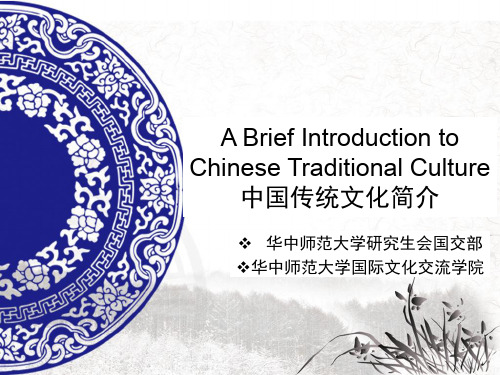
Chinese Inventions
Chinese Inventions
Compass is very important in traveling outside, and this is just a great invention of Chinese.
The compass composed of a magnetic spoon and a copper plate with orientation marks. Turn the spoon and let it running, when it stops, the handle of it will points to the South.
Chinese Zodiac and
Dragon
Chinese Zodiac
The Chinese Zodiac (生肖) consists of twelve animal signs, each representing a year according to the lunar calendar. The twelve animal signs are: Rat; Ox; Tiger; Rabbit; Dragon; Snake; Horse; Sheep; Monkey; Chicken; Dog and Pig.
Emperor Huang and Yan
Every year, on the Tomb-sweeping Day (usually on April 5th), thousands of Chinese people come back from all over the world to the tomb of their oldest ancestors in Shaanxi province to participate the annual memorial ceremony..
矿产
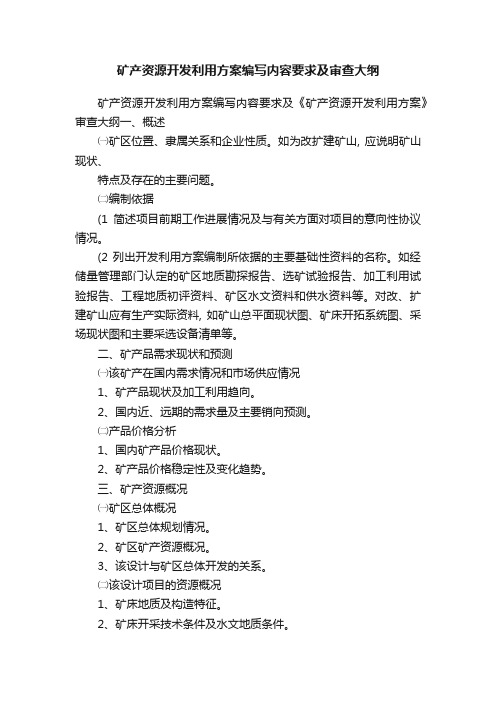
矿产资源开发利用方案编写内容要求及审查大纲
矿产资源开发利用方案编写内容要求及《矿产资源开发利用方案》审查大纲一、概述
㈠矿区位置、隶属关系和企业性质。
如为改扩建矿山, 应说明矿山现状、
特点及存在的主要问题。
㈡编制依据
(1简述项目前期工作进展情况及与有关方面对项目的意向性协议情况。
(2 列出开发利用方案编制所依据的主要基础性资料的名称。
如经储量管理部门认定的矿区地质勘探报告、选矿试验报告、加工利用试验报告、工程地质初评资料、矿区水文资料和供水资料等。
对改、扩建矿山应有生产实际资料, 如矿山总平面现状图、矿床开拓系统图、采场现状图和主要采选设备清单等。
二、矿产品需求现状和预测
㈠该矿产在国内需求情况和市场供应情况
1、矿产品现状及加工利用趋向。
2、国内近、远期的需求量及主要销向预测。
㈡产品价格分析
1、国内矿产品价格现状。
2、矿产品价格稳定性及变化趋势。
三、矿产资源概况
㈠矿区总体概况
1、矿区总体规划情况。
2、矿区矿产资源概况。
3、该设计与矿区总体开发的关系。
㈡该设计项目的资源概况
1、矿床地质及构造特征。
2、矿床开采技术条件及水文地质条件。
- 1、下载文档前请自行甄别文档内容的完整性,平台不提供额外的编辑、内容补充、找答案等附加服务。
- 2、"仅部分预览"的文档,不可在线预览部分如存在完整性等问题,可反馈申请退款(可完整预览的文档不适用该条件!)。
- 3、如文档侵犯您的权益,请联系客服反馈,我们会尽快为您处理(人工客服工作时间:9:00-18:30)。
黄 昏 下 的 长 城
万里长城 —盘沿在中国的巨龙
The Great Wall is located in the northern part of China, it Shanhaiguan in Bohai Bay, Hebei Province, east, west to Jiayuguan in Gansu Province inland areas. Trans-Hebei, Beijing, Inner Mongolia, Shanxi, Shaanxi, Ningxia, Gansu and other seven provinces, municipalities and autonomous regions, and total length of about 6,700 kilometers, about 13.3 thousand years, in the world,
中国京剧艺术大师梅兰芳,舞台生涯五十多年。他与饭店感 情颇深:天津是他每年必到之地,来即下榻来即下榻利顺德 332房间,梅先生多次入住饭店与饭店员工结下了深情,饭店 将332房间恭修为“兰芳套房”。梅先生的艺术风采和音容笑 貌在这里留下了深深的回忆。 京剧行当中梅兰芳最擅演的是 “旦”.京剧中把女性统称为“旦”,其中按照人物的年龄、 性格又可细分为许多行当,饰演大家闺秀和有身份的妇女称 为“正旦”,正旦在京剧中俗称“青衣”,这就是因为正旦 所扮演的角色常穿青色的长衫而得名。京剧《窦娥冤》中的 女主角窦娥就是典型的青衣角色。青衣的表演庄重娴静,秀 雅柔婉,以唱功为主,一般说来,青衣的唱腔旋律优美,细 腻婉转。 梅兰芳先生在促进我国与国际间文化交流方面作出 了卓越的贡献。他是我国向海外传播京剧艺术的先驱。他曾 于1919年、1924年和1956年三次访问日本,1930年访问美 国,1935年和1952年两次访问苏家、 作家和画家,同他们建立了诚挚的友谊。他的这些活动不仅 增进了各国人民对中国文化的了解,也使我国京剧艺术跻入 了世界戏剧之林。 梅兰芳先生是中国表演艺术的象征,是我 国人民的骄傲。
Beijing opera
Peking Opera combines music, acrobatic dance, and spectacular costumes to tell stories from Chinese history and folklore. Using abstract, symbolic gestures rich in dramatic meaning, actors represent personages from the heroic, divine, and animal worlds, often in martial exploits. The traditional features of the masklike makeup and elaborate costumes immediately identify the characters to a knowing audience.
the "Great Wall" reputation. The Great Wall in China's vast land of the north east and west lie the rolling one, imposing, as long as more than ten thousand li long wall. This is considered the world's architectural history of the Great Wall a great miracle. Great Wall is China's ancient defense project is a great crystallization of ancient Chinese people's strong determination and a high degree of wisdom in ancient China embodies the remarkable achievements of engineering technology, but also shows the Chinese nation's long history.
李小龙简介 李小龙英文简介 李小龙传奇简介 姓名:李小龙 妮称:细凤 英文 名字:Bruce lee 生日:1940年11月27日;籍贯:广东顺德;星座:射手座; 身高:173CM;体重:65KG;血型:O;学历:西雅图华盛顿州立大学;婚 姻状况:已婚;讨厌的地方:虚伪的社交场合;常到的地方:健身房,图书 馆,公园;最喜欢的运动:技击术;最喜欢的动物:狗;最喜爱的国家:中 国;嗜好:练武,冥想,跳舞,阅读;优点:正直善良,智慧超群;缺点: 至今没发现;其它:妻子:琳达;儿子:李国豪;女儿:李香凝;个人座右 铭:以无法为有法,以无限为有限;最喜欢的歌曲:《当我死去时》李小龙 葬礼上就播了此曲,天妒英才,悲哉! 六十年代后期,李小龙回香港发展电 影事业,先后主演了《唐山大兄》、《精武门》、《龙争虎斗》、《猛龙过 江》等电影,引起世界轰动;最后一部电影是《死亡游戏》。1973年7月20 日因病逝世。李小龙的逝世,不仅是武术界的损失,而且是电影界的损失。 遗着有《截拳道》、《功夫纪录》、《双节棍法》、《截拳道研究》。世界 各地成立了李小龙学会,研究李小龙的武术造诣。 1999年李小龙获《时代》 杂志评为“二十世纪的英雄与偶像”。他一生短暂、充满传奇,功夫盖世、 流芳千秋! 李小龙的一生是短暂的,但却如同一颗耀眼的彗星划过国际武坛 的上空,对现代技击术和电影表演艺术的发展作出了巨大的贡献。他主演的 功夫片风行海外,中国功夫也随之闻名于世界。许多外文字典和词典里都出 现了一个新词:“功夫”。在不少外国人心目中的功夫就是中国武术,李小 龙也成了功夫的化身 。
功夫之王—李小龙
Hong Kong kungfu star Bruce Lee's family plans to shoot a new movie about the martial arts and film legend to dispel the myths that have arisen since his death 33 years ago. Speaking at a gathering to mark the anniversary of the star's death in 1973, younger brother Robert Lee Chun-fai said the legend had never faded but few people knew the real Bruce Lee. He said this year the whole family decided to launch a book to mark his birthday in November and they would record a film to show the other side of Bruce, how he was growing up, his secrets and his philosophy from the never-seen perspective of his brothers and sisters. The film will be shot next year by JA Media in co-operation with brothers Robert and Peter and sisters Phoebe and Agnes, and is scheduled to air on the 35th anniversary of Bruce Lee's death in 2008. JA Media movie producer Stephen Shin Kei-yin said they would trawl the world to find the right actor to portray Lee
梅 兰 芳 贵 妃 醉 酒
a century of astor (6) beijing opera floats overseas Mr Meilanfang, the master of Peking Opera, spent more than fifty years on the stage. During those years he came to Tianjin every year and the Astor Hotel was his favorite hotel. The room 332 became his home for many years and he developed a deep friendship with the clerks there. The room is called the Lanfang Suite. Meilanfang is good at playing the role of women in Beijing operas, called “Dan”. According to the age and personality of the character, there are many different kinds of Dans. If she is a decent girl, will be called “Zhengdan” or “Qingyi” if she is just a young girl; the character on the stage is usually dressed in blue. The heroine of “Dou E’s Grievance” is a typical “Qingyi” character. This kind of character is supple and elegant; the singing skill is the most important technical point and the song itself is soft and beautiful.
